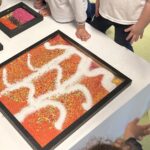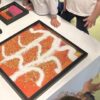Fostering higher-order thinking through the visible thinking approach
Escrito por: Diana Carolina Santana Cabrera – Inglés
Resumen
This paper explores strategies for fostering higher-order thinking skills through the Visible Thinking Approach. It emphasizes the importance of making thinking visible, cultivating a culture of thinking, and using structured routines to document student thought processes and enhance metacognitive awareness.
Introduction
In today’s information-driven world, students are often assessed on their ability to recall facts rather than their capacity to think critically. But is memorization enough? Education experts argue that developing higher-order thinking skills is crucial for success in the 21st century.
In many educational contexts, educators commonly design their lessons in alignment with Bloom’s Taxonomy (Bloom, B., & Mesia, B., 1964), which establishes a cognitive hierarchy: knowledge, comprehension, application, analysis, synthesis, and evaluation. From this perspective, teachers associate thinking with specific cognitive processes. However, the hierarchical structure of Bloom’s taxonomy, moving from lower-order to higher-order skills, has been questioned and further improved. Anderson and Krathwohl (2001) proposed a revised sequence: remembering, understanding, applying, analyzing, evaluating, and creating, which remains open to debate. Although education has undergone various innovations in metacognition, modern educators must not only guide students from lower-order to higher-order thinking skills but also teach for understanding. This involves making thinking visible, fostering a culture of thinking, and implementing thinking routines to enhance students’ cognitive engagement.
Making Thinking Visible
One of the greatest challenges for teachers is engaging students in the process of thinking and discussing their own cognitive processes. This difficulty arises from the differences between concrete and abstract ways of thinking (Salmon, 2010). Consequently, teachers must identify effective strategies to help students externalize their thought processes.

A key method for making thinking visible is the documentation of students’ evolving ideas as they reflect on various subjects, such as environmental issues, historical events, values, and personal experiences. Teachers can document student thinking through tools such as video recordings, transcribed conversations, and portfolios containing students’ work, complemented by images, mind maps, concept maps, and reflective writings. According to Roskos and Christie (cited in Salmon, 2010), documenting students’ responses and reflections on specific topics enhances their metacognitive awareness, thereby fostering deeper intellectual development (Lantolf & Thorne, 2006).
“One of the greatest challenges for teachers is
engaging students in the process
of thinking and discussing their
own cognitive processes.”
Moreover, documentation helps students connect prior knowledge with new concepts. Miller and Calfee (2004) found that the use of graphic organizers in science classes enabled students to organize, reflect on, and extend their learning. Thus, implementing various documentation strategies supports making thinking visible. Additionally, students can externalize their thought processes through class discussions, written reflections, and other expressive activities that reinforce their cognitive engagement (McLean, 2012). Providing students with opportunities to visualize and articulate their thinking promotes higher-order thinking skills by encouraging continuous reflection and refinement of their ideas.
Cultivating a Culture of Thinking
While documenting students’ thought processes is essential, fostering a classroom environment that nurtures these cognitive skills is equally important. This is where the concept of a culture of thinking comes into play.
Salmon (2008) defines a culture of thinking as an environment where both individual and collective thinking is valued, visible, and actively promoted in daily classroom activities (p. 458). A culture of thinking is established through social practices that foster thinking dispositions—habits of mind that promote productive thinking and can be cultivated over time across different contexts (Colcott, Russell, & Skouteris, 2009).

Teachers play a crucial role in developing students’ thinking dispositions, which help cultivate a culture of thinking in the classroom. Thinking dispositions can be nurtured through thinking routines—structured approaches that allow teachers to observe student responses, infer their cognitive processes, and refine instructional strategies accordingly.
Implementing Thinking Routines
Thinking routines serve as valuable tools for fostering thinking dispositions and encouraging intellectual engagement. Salmon (2010) defines thinking routines as “a series of questions that teachers ask students to guide them through critical thinking steps” (p. 27). These structured yet flexible strategies enable learners to connect prior knowledge with new content, facilitating deeper understanding.
Thinking routines can be applied across various subject areas to promote self-directed learning and enhance comprehension. The choice of a specific routine depends on the type of thinking the teacher seeks to cultivate. For example, the routine What makes you say that? encourages students to justify their interpretations, fostering analytical thinking. Similarly, Circle of viewpoints promotes perspective-taking by helping students explore diverse viewpoints on a given topic. These routines enhance students’ cognitive development by guiding them through higher order thinking processes and helping them develop critical thinking habits.
Conclusion
This reflection has explored strategies that contemporary educators can adopt to support students in transitioning from lower-order to higher-order thinking skills. First, fostering a language of thinking in the classroom and documenting students’ cognitive processes are powerful tools for making thinking visible. Second, cultivating a culture of thinking encourages both teachers and students to develop thinking dispositions that support intellectual growth. Third, thinking routines offer adaptable strategies for fostering cognitive engagement across different subject areas, tailored to students’ needs and learning objectives.
By fostering a culture of thinking and using structured thinking routines, educators can equip students with the cognitive tools necessary for lifelong learning. The question remains: How can we, as educators, continuously evolve our teaching strategies to ensure that thinking becomes as fundamental as learning itself?
“By fostering a culture of thinking and using structured
thinking routines, educators can equip students with
the cognitive tools necessary for lifelong learning.“
Bibliografía
- Anderson, L. W., & Krathwohl, D. R. (2001). A taxonomy for learning, teaching, and assessing: A revision of Bloom’s taxonomy of educational objectives. New York Longman, 302. https://doi.org/10.1207/s15430421tip4104_2
- Bloom B., B. Mesia, and D. K. (1964). Bloom’s Taxonomy. New York. David McKay.
- Colcott, D., Russell, B., & Skouteris, H. (2009). Thinking about thinking: innovative pedagogy designed to foster thinking skills in junior primary classrooms. Teacher Development, 13(1), 17–27. https://doi.org/10.1080/13664530902858477
- Lampinen, J. M., & Arnal, J. D. (2009). A Revision of Bloom’s Taxonomy: An Overview. American Journal of Psychology, 122(1), 39–52. https://doi.org/10.1207/s15430421tip4104
- Lantolf, J. P., & Thorne, S. L. (2006). Sociocultural Theory and Second Language Learning. Theories in Second Language Acquisition, 201–224. https://doi.org/10.1177/0022219409345018
- McLean, A. (2012). Making Thinking Visible: How to Promote Engagement, Understanding, and Independence for All Learners – By Ron Ritchart, Mark Church and Karin Morrison. Support for Learning, 27(2), 92–93. https://doi.org/10.1111/j.1467-9604.2012.01520.x











